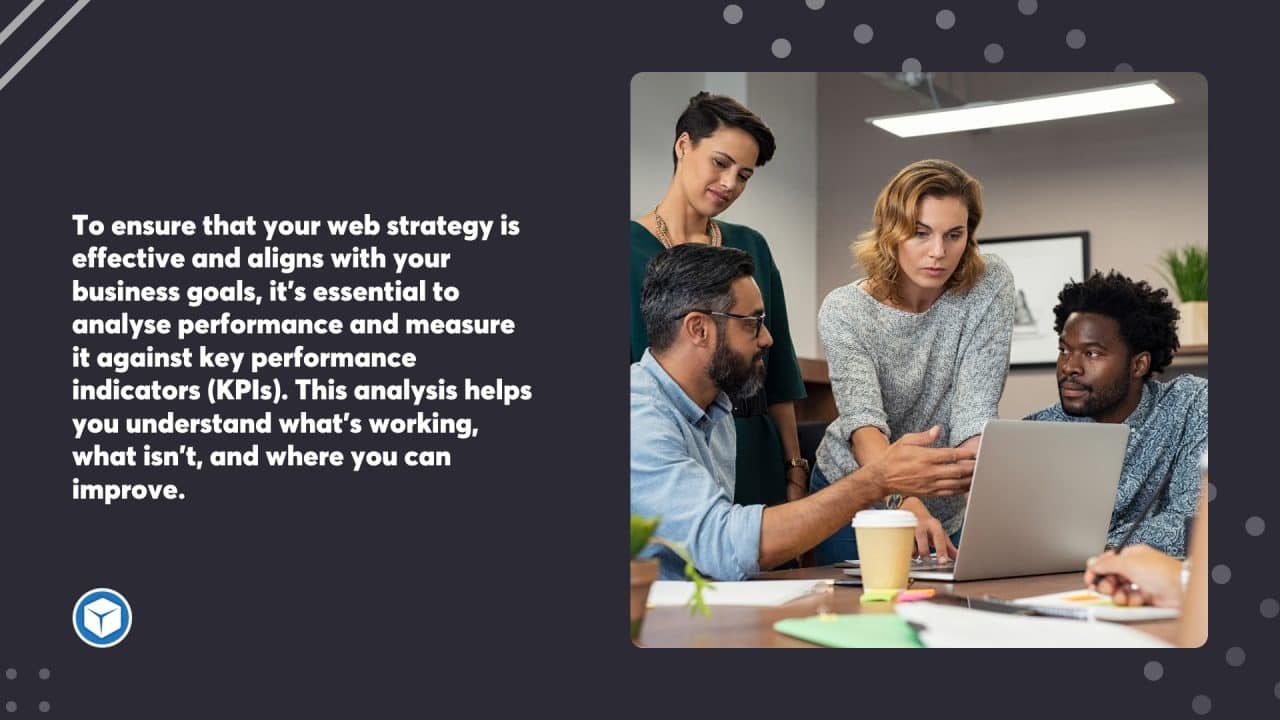
A website acts as a company’s digital storefront, often serving as the first point of contact between a business and its customers. This means that formulating a sound web strategy is pivotal, encompassing clear goals, a user-friendly design, and content that aligns with the business objectives. Whether the aim is to enhance brand awareness, increase sales, or provide valuable information, a coherent strategy sets the stage for achieving these outcomes effectively.
A world-class web strategy includes a thorough analysis of the target audience, an assessment of the competitors in the space, and a strategic approach to content creation and dissemination.
Key elements such as search engine optimisation, responsive design, and social media integration play important roles in making a website strategy effective. It connects all aspects of an organisation’s online presence, ensuring that each part supports and enhances the others.
With 3.9 million websites being created every day, a well-crafted web strategy has become a fundamental foundation piece for standing out above the crowd.
Key Takeaways
- Clearly Defined Objectives: A successful web strategy hinges on setting clear, measurable goals that are directly aligned with the business’s overall objectives. Whether it’s driving sales, generating leads, or increasing brand awareness, each element of the website should be strategically designed to contribute to these targets.
- User-Centric Design and Content: Understanding the target audience is critical. By conducting user research and analysis, businesses can create a website that not only meets the audience’s needs but also facilitates a seamless and engaging user experience. Web content should be valuable and relevant to the audience, designed to build engagement and position the business as an authority in its field.
- Integrated Digital Presence: A web strategy should not exist in isolation but rather be part of a broader digital ecosystem. This means integrating the website with social media, optimising for search engines, and ensuring mobile responsiveness. These elements work together to boost the website’s visibility, drive organic traffic, and enhance the user experience across all digital touchpoints.

Table of Contents
What Is the Goal of Your Website?
Businesses must clearly define their website goals to create a strategic approach that aligns with their objectives. Website goals form the direction for any successful website, providing a foundation for all further strategies. Creating a custom website that meets specific needs and goals is essential for driving conversions and staying competitive.
The best approach towards website development should articulate how each website element aids in achieving the overall objective. Businesses should frequently assess their website’s effectiveness, adapting their approach based on analytics and user feedback to maintain alignment with their strategic goals.
This focus ensures that every aspect of the website is carefully considered and contributes to the broader success of the business online.
What Does a Website Strategy Include?
At Chillybin we believe a comprehensive website strategy looks at six key components that collectively contribute to a site’s success, from initial assessment to content creation and user interaction. Effective web strategies include tailored solutions, industry insights, and a commitment to client success, driving leads and online enquiries.
Here are the six components we walk clients through in our bespoke Website Strategy service.
Website Evaluation
A thorough website evaluation examines the current state of a website from a business perspective, taking into account search engine ranking and key performance indicators (KPIs). It identifies the strengths to maintain and the challenges to address.
User Research & Analysis
User research and analysis are pivotal in understanding the target audience. By developing user personas, businesses gain actionable insights that shape a site’s development, ensuring it meets audience needs and preferences.
Market Research
Conducting market research helps in understanding the digital space where the business operates. By analysing your competitors, we can infuse the website with competitive edges, keep your business ahead of new trends, and position the website for now and into the future.
Wireframing
Wireframing is a key element in visualising the user journey. It serves as a blueprint for guiding users towards desired actions, such as reaching a landing page. This simplifies complex ideas into workable plans.
High-Fidelity Mockups
Creating high-fidelity mockups involves the detailed visual design of an interactive prototype that you can touch and feel. This step ensures that the visual elements align with the brand for immediate brand recognition and helps in establishing the value proposition through high-quality visuals.
Prototyping
Prototyping allows for the simulation of the user experience before the site goes live. It is a practical phase where feedback is collected on new features, ensuring the site aligns with business goals and user expectations.
Each of these steps contributes to turning a website into an effective business tool that resonates with both the company’s objectives and the audience’s expectations.

What Are The Keys To A Successful Website Strategy?
Developing a strong website strategy is essential for establishing a thriving business online. A well-crafted approach guides digital marketing efforts, enhances user experience, and strengthens search results.
Understanding Your Target Audience
A cornerstone of any successful web strategy is a deep understanding of your target audience. Knowing who your users are, what they need, and how they interact with you is crucial for creating a website that resonates with them and meets their expectations. Here are the essential steps to gain a profound insight into your audience:
Conduct Thorough Market Research
Begin by gathering demographic data such as age, gender, location, and income level. But don’t stop there—look into psychographic information like interests, hobbies, values, and lifestyle. This data can often be collected from market research reports, social media analytics, and customer surveys. Understanding these aspects will allow you to tailor your content, design, and user experience to match the preferences of your audience.
Develop Detailed User Personas
User personas are fictional characters created to represent the different user types that might use your service, product, or website in a similar way. Crafting these personas involves a combination of market research and real data about your existing customers. Personas should include background, demographics, goals, pain points, and behavioural traits. These personas will guide your content strategy, design choices, and feature development.
Analyse Search Query Data
Search query data can provide valuable insights into what your target audience is searching for and the language they use. By conducting keyword research, you can discover the terms and phrases your audience uses and the intent behind their searches. This information helps in optimising your website’s content for search engines and ensuring that it addresses the topics and questions important to your audience. Tools like Google Analytics and Google Search Console can be instrumental in this analysis.
Utilise Analytics for User Behaviour Insights
Web analytics tools can give you a clear picture of how users interact with your site. Analyse metrics such as page views, bounce rate, and conversion paths to understand what content is engaging your audience and where there may be pain points in the user journey. This data should inform adjustments to your site to improve the user experience.
Engage with Your Audience
Direct engagement through social media, surveys, and feedback forms can provide qualitative insights into your audience’s preferences and experiences. Engaging with your audience can validate the assumptions made from quantitative data and fill in gaps in your understanding.
Monitor and Adapt to Trends
Audience preferences and behaviours can change over time, so it’s important to keep an eye on trends and be ready to adapt your strategy. This may involve staying up-to-date with industry news, monitoring changes in search engine algorithms, and being responsive to new user feedback.
Implement A/B Testing
A/B testing different elements of your website with segments of your audience can reveal preferences and behaviours that you might not have anticipated. This empirical approach allows you to make data-driven decisions about design and content.

Designing for Usability and Impact
Designing for usability and impact is about creating a website that is not only aesthetically pleasing but also functionally effective and easy to use. This ensures that users can find what they’re looking for and have a positive experience interacting with your site. Here’s how to approach this critical aspect of your web strategy:
Prioritise Intuitive Navigation
The structure of your website should be logical and intuitive. A well-thought-out information architecture makes it easy for users to navigate and find content quickly. This includes a clear menu hierarchy, logical page flows, and a search feature that helps users find specific content. Breadcrumbs, which show the path to the current page, can also enhance navigability.
Embrace Responsive Design
With the variety of devices used to access the internet today, responsive design is non-negotiable. Your website must function well on desktops, tablets, and smartphones of all sizes. This involves flexible layouts, resizable images, and adaptable menus. A mobile-friendly website ensures all users have a positive experience, regardless of their device.
Optimise Page Load Times
Users expect fast-loading pages. Slow load times can lead to increased bounce rates and lost conversions. Optimise images, leverage browser caching, and minimise the use of heavy scripts to ensure your pages load quickly. Regularly test your site’s performance on tools such as GT Metrix, and seek ways to improve it.
Ensure Accessibility
Web accessibility means making your site usable for people of all abilities and disabilities. This includes providing alt text for images, ensuring keyboard navigation, and using sufficient contrast for text and background colours. Following the Web Content Accessibility Guidelines (WCAG) can help make your website more accessible.
Create Engaging Content
Content is the heart of your website. It should be engaging, informative, and aligned with your brand voice. Use headings, subheadings, bullet points, and images to break up text and make content easy to scan. Videos and infographics can also be powerful tools for engaging users and conveying information in an impactful way.
Implement Clear Calls to Action (CTAs)
CTAs guide users towards the actions you want them to take, such as making a purchase, signing up for a newsletter, or contacting your business. They should stand out and be placed strategically throughout your website. The language should be action-oriented and create a sense of urgency or benefit.
Test and Iterate
Usability isn’t a one-time task—it’s an ongoing process. Conduct usability testing with real users to gather feedback on how they interact with your site. Use this feedback to make continuous improvements. A/B testing can also help determine which design elements work best for your audience.
Leverage Visual Hierarchy
Visual hierarchy is the arrangement of elements in order of importance. It guides the user’s eye to the most critical information first. Use size, colour, contrast, and placement to establish a clear visual hierarchy that aligns with your objectives.
Focus on Readability
The legibility of your content is crucial. Choose fonts and colours that are easy to read. The size of your text should also be appropriate for reading on screens, with ample line spacing and paragraph breaks to enhance readability.

Leveraging Content for Engagement
Creating and leveraging content for engagement is an essential strategy for any website looking to build a rapport with its audience, enhance online visibility, and drive more traffic. Here’s how to effectively use content to engage your audience:
Develop a Content Strategy
Identify the interests and needs of your target audience to create a content strategy that resonates with them. This includes deciding on the types of content—such as blog posts, videos, and infographics—that will most effectively convey your message and encourage interaction.
Create Valuable and Relevant Content
The core of your engagement efforts is the website content itself. It should provide value, answer questions, solve problems, or entertain your audience. High-quality content is more likely to be shared and can help establish your brand as an authority in your field.
Encourage User Interaction
Invite your audience to engage with your content through comments, shares, and other interactive elements. This fosters a community around your brand and signals to search algorithms that your content is valuable and relevant.
Utilise Multimedia
Diversify your content by incorporating multimedia elements like images, videos, and podcasts. These can make your content more engaging and accessible to a wider audience, as different people prefer different types of content.
Optimise for Shareability
Make it easy for visitors to share your content by including social sharing buttons and creating share-worthy headlines. Content that is widely shared can significantly increase traffic to your site and improve your brand’s reach.
Implement a Content Calendar
A content calendar helps you plan and publish content consistently, which is key to keeping your audience engaged and coming back for more. It also allows you to prepare for key events or seasons relevant to your audience.
Measure Content Performance
Use analytics tools to track how your content is performing in terms of engagement metrics like page views, time on page, likes, comments, and shares. This data will help you understand what works and refine your content strategy over time.
Create Interactive Content
Interactive content such as quizzes, polls, and surveys can significantly increase user engagement. They provide a fun way for users to interact with your brand and can offer valuable insights into your audience’s preferences.

Optimisation for Search (SEO)
SEO is a crucial aspect of establishing and maintaining online visibility. It’s a multifaceted approach that enhances your website’s appeal not just to users but also to the algorithms that determine search rankings. Here’s how to refine your SEO strategy:
Keyword Research Foundations
Begin by identifying the words and phrases most relevant to your website content. This foundational step ensures that you’re visible in searches that align with your audience’s interests, ultimately helping to drive more traffic to your site.
On-Page Content Optimisation
Optimising your website involves fine-tuning the content to speak directly to your audience’s needs while also signalling relevance to search algorithms. This includes using targeted keywords strategically and creating valuable, informative content that engages readers and encourages them to share.
User Experience and Usability
A website that is easy to navigate and enjoyable to use is more likely to retain visitors and encourage them to explore more pages, which can increase traffic over time. This includes ensuring fast load times, mobile-friendly design, and clear calls to action.
Build a Robust Profile of Back Links
Back links from reputable sites not only bring direct traffic but also serve as endorsements that can boost your standing in search results. Acquiring these links through high-quality content, outreach, and partnerships is a key part of any SEO strategy.
Technical SEO
The technical aspects of your site, such as structured data, clean URLs, and a sitemap, help ensure that search algorithms can crawl and index your content effectively. Regular audits can help catch and resolve issues that might impede your site’s performance.
Local and Mobile Optimisation
With the increasing use of mobile devices for internet access, local and mobile optimisation is more important than ever. Ensure that local searchers can easily find you, and that your site provides a stellar experience on all devices.
Monitor, Analyse, and Adapt
SEO is not a set-it-and-forget-it task. Use analytics to monitor your site’s performance, keep abreast of changes in search algorithms, and adapt your strategies to continue improving your site’s visibility and traffic.

Integrating Social Media and Digital Services
Incorporating social media and digital services into your web strategy is pivotal for crafting an effective website that resonates with modern consumers. By doing so, you can leverage these platforms to enhance your brand’s online presence, engage with your audience, and drive website traffic.
Create a Unified Brand Experience
A consistent brand experience is crucial across all digital platforms. This uniformity helps in improving your search engine ranking as consistent information across platforms is often rewarded by algorithms. Ensure your branding, messaging, and visual elements are coherent, whether a user is interacting with your social media page or your main website.
Enhance Site Functionality with Social Features
Adding social media feeds to your website can keep content dynamic and encourage user interaction. Social sharing buttons are also essential, making it simple for visitors to disseminate your content across their networks, which can naturally increase your site’s traffic.
Utilise Social Channels for Customer Support
For most businesses, social media has become an indispensable customer service tool. Providing support through these channels can improve customer satisfaction and foster a sense of community. Integrate technical aspects like chatbots to offer instant support and direct users back to your website for detailed information.
Display Social Proof
Social proof, such as user testimonials and reviews shared on social media, can be powerful when displayed on your website. This not only serves as a trust signal to new visitors but can also positively influence your website’s conversion rates.
Sync E-commerce with Social Media
Integrating e-commerce functionalities with social media platforms allows for a seamless shopping experience. This is particularly effective for businesses aiming to capitalise on the impulse buying behaviour that social media can trigger.
Harness Targeted Social Advertising
Social media advertising can be highly targeted to reach specific audience segments, leading to more efficient ad spend and better achievement of the desired outcome, whether that’s increased brand awareness or direct sales.
Cross-promote with Email Marketing
Link your email marketing initiatives with your social media strategy to amplify your message. Encourage email subscribers to engage with your social content, and vice versa, to build a cohesive community around your brand.
Track Performance Across Platforms
Implementing robust analytics allows you to measure the effectiveness of your social media integration. Monitor how social interactions contribute to your overall web strategy and adjust tactics to optimise engagement and traffic.
Foster Active Community Engagement
Engage your audience with interactive social media campaigns that promote active participation. This not only boosts engagement but also encourages users to visit your website, thereby increasing traffic and the potential for conversions.
Optimise for Platform-Specific Search
Tailor your social media content to perform well in platform-specific searches. This means using the right hashtags, engaging descriptions, and content that resonates with your audience, which can lead to greater visibility and traffic from these channels.

Enhancing Mobile Experience
Enhancing the mobile experience is essential as more users access the internet via mobile devices. A mobile-friendly website improves usability for on-the-go users and also contributes to better search engine rankings due to mobile-first indexing. Here’s how to optimise the mobile experience:
Implement Responsive Design
Responsive design is non-negotiable for an effective website. It ensures that your site looks and functions well on all screen sizes, providing a seamless experience for mobile users.
Optimise for Speed
Mobile users expect quick load times. Optimise images, minify code, and leverage browser caching to speed up your site. Google’s PageSpeed Insights can be a valuable tool for identifying opportunities to improve load times.
Simplify Navigation
Mobile screens are smaller, so it’s important to have a simple, clear navigation structure. Large, easy-to-tap buttons and a minimised menu that doesn’t overwhelm the user are key to a positive mobile experience.
Design for Touch
Design interactive elements for touch, with enough space to prevent errors. The touch targets should be large enough for users to tap without accidentally hitting the wrong button.
Prioritise Content
On mobile, screen real estate is at a premium. Prioritise content and features that mobile users need most, and consider the content-to-chrome ratio, ensuring that the user’s view is dominated by content, not unnecessary design elements.
Ensure Readability
Text should be easily readable on small screens without needing to zoom. Use fonts and colours that are legible on mobile, and adjust line spacing and paragraph size for clarity.
Use Mobile-Friendly Forms
Forms should be optimised for mobile use, with fields that are easy to fill out on touchscreens and with the appropriate input types for different data fields to facilitate form completion.
Test on Real Devices
Test your mobile site on actual devices to understand the real-world experience. Emulators are useful, but nothing beats real-world testing to ensure your mobile site meets user expectations.
Monitor Mobile Analytics
Use analytics to track mobile usage and understand how mobile users interact with your site. Look at metrics like mobile conversion rates and bounce rates to gauge the effectiveness of your mobile experience.

Maintaining and Updating Content
Regularly maintaining and updating your website content is key to keeping your site relevant, engaging, and performing well in terms of SEO. It ensures that visitors have a reason to return and that your site remains a reliable resource. Here’s how to approach content maintenance:
Establish a Review Schedule
Set up a schedule for regularly reviewing and updating content. This could be monthly, quarterly, or biannually, depending on the nature of your content and industry. Consistent reviews help identify areas that need refreshing and ensure that information stays current.
Update Outdated Information
Keep an eye out for any outdated statistics, references, or information that may have changed over time. Updating this content is crucial for maintaining the trust of your visitors and for your credibility.
Refresh Evergreen Content
Evergreen content remains relevant long after publication but may need updates to stay current. Revisit these pieces to add new insights, statistics, or related developments to keep them useful and improve their longevity.
Optimise for Current SEO Best Practices
SEO evolves continuously, and what worked in the past may not be as effective now. Review your content to ensure it aligns with the latest SEO guidelines and practices, including keyword usage and meta tags.
Monitor Performance Metrics
Use analytics to monitor how your content performs. Look at metrics like page views, bounce rate, and time on page to understand what content resonates with your audience and what might need improvement.
Remove or Revise Underperforming Content
Analyse content that isn’t performing well and decide whether to update it to make it more relevant or remove it if it’s no longer useful. This helps maintain a high-quality standard for your website.
Encourage User Feedback
User feedback can provide insights into what content your audience finds useful or lacking. Encourage comments, surveys, or feedback forms to gather this valuable information.
Keep Up with Industry Trends
Stay informed about changes and trends in your industry to ensure that your content reflects current practices and knowledge. This helps establish your website as a thought leader in your field.
Utilise Content Management Systems
Content management systems (CMS) can streamline the process of content updates. Use these tools to schedule posts, manage revisions, and collaborate with team members.

Analysing Web Strategies for Performance and KPIs
To ensure that your web strategy is effective and aligns with your business goals, it’s essential to analyse performance and measure it against key performance indicators (KPIs). This analysis helps you understand what’s working, what isn’t, and where you can improve. Here’s how to approach the analysis of your web strategies:
Define Clear KPIs
Start by defining clear KPIs that are aligned with your business objectives. These could include website traffic, conversion rates, bounce rates, average session duration, and others that are relevant to your specific goals.
Utilise Analytics Tools
Implement analytics tools, such as Google Analytics, to gather data on your website’s performance. These tools can provide insights into user behaviour, traffic sources, content engagement, and conversion paths.
Regular Reporting
Create regular reports that track your KPIs over time. This will help you identify trends, patterns, and anomalies that can inform your decision-making process.
Segment Data for Deeper Insights
Segment your data to gain deeper insights into specific audiences, campaigns, or time periods. This can help you understand the effectiveness of targeted strategies and where to focus your efforts for maximum impact.
Conduct A/B Testing
Use A/B testing to experiment with different elements of your web strategy, such as page layouts, content, and calls to action. This empirical approach allows you to make data-driven decisions about what changes lead to better performance.
Monitor Conversion Funnels
Analyse your conversion funnels to see where users drop off and where they convert. This can help you identify and fix any barriers to conversion, improving the overall effectiveness of your website.
Assess User Feedback
Collect and assess user feedback to gain qualitative insights into your website’s performance. This can complement your quantitative data and provide a fuller picture of user experience.
Benchmark Against Competitors
Compare your performance against industry benchmarks or direct competitors to understand your position in the market and identify areas for improvement.
Review and Adapt Strategies
Based on your analysis, review and adapt your web strategies. Be prepared to pivot or make iterative changes to continuously enhance your website’s performance.
Invest in Continuous Learning
Stay informed about the latest trends and best practices in web strategy and analytics. Continuous learning will help you refine your approach to measuring and analysing performance.

How To Get A Winning Website Strategy
A solid website strategy crafted by professionals is a powerful asset for any business aiming to achieve its goals efficiently. By entrusting experts with the creation of a winning web strategy before building your site, you position your brand to cut through the noise and connect with your audience effectively. The right strategy accelerates progress, ensuring that every digital interaction moves you closer to your objectives.
To put your project on the path to success, contact the team at Chillybin today.




